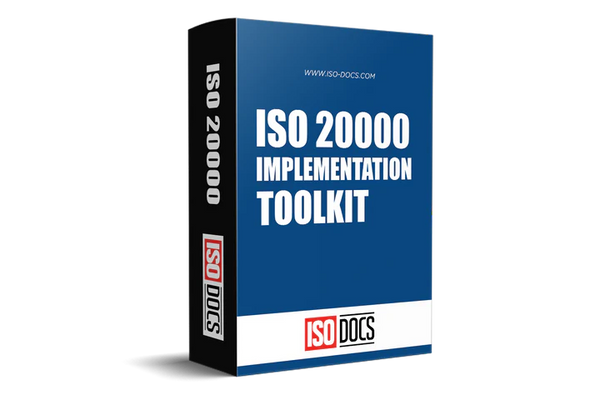ISO 20000 Service Design and Transition Process Template
What are Service Design and Transition Processes?
ITIL Service Design and Transition Process is a process within the ISO 20000 standard that enables an organization to design and transition new or changed services. This process ensures that new or changed services meet the organization's requirements and are introduced into the operational environment in a controlled and predictable manner.

The Service Design and Transition Process consist of the following activities:
1. Service design planning
2. Service design
3. Service transition planning
4. Service Transition
5. Service asset and configuration management
6. Release and deployment management
7. Change management
8. Service validation and testing
9. Evaluation
The Objective of Service Design ITIL Service Design and Transition Processes :
Service Design aims to design and implement a service that meets the customer's current and future needs in the most effective way. The Service Design stage of the service lifecycle includes the processes and activities needed to design and implement a new service or significantly change an existing one.
ITIL Service Design and Transition Processes in ISO 20000 cover the design, development, testing, and deployment of new or changed services. They also address the management of changes to services and service components. These processes and activities must be closely coordinated with the other stages of the service lifecycle to ensure a smooth and successful transition to live operation.
Service Design and Transition processes in ISO 20000 are closely aligned with the corresponding processes in the ITIL framework. However, there are some important differences. ISO 20000 places greater emphasis on the management of changes to services and service components and the need for effective communication and coordination between all parties involved in the design, development, and deployment of new or changed services.
The main objectives of the Service Design and Transition processes are to:
• Design new or changed services that are fit for purpose and meet the needs of the business
• Ensure that all changes to services and service components are managed in a controlled and consistent way
• Deploy new or changed services in a coordinated and planned manner
• Ensure that all stakeholders are kept informed of progress and that any risks or issues are identified and managed
• Test new or changed services to ensure that they are fit for purpose
• Maintain an effective service catalog that accurately reflects the current state of the services.
The Scope of Service design and Transition Processes :

Scope of service design:
The scope of service design includes all the activities necessary to design, develop, document, test, and implement new or changed services. The aim is to achieve an agreed, consistent, and cost-effective service that meets the needs of customers and other stakeholders.
The scope of service design covers all aspects of designing a new service or making changes to an existing one. This includes defining the service requirements, designing the service solution, and creating the service plan. It also covers testing the design and implementing the new or changed service.
To ensure a successful outcome, all parties involved should agree on the scope of service design at the outset. It is also essential to consider the impact of any changes on other parts of the organization and to have a plan to manage these impacts.
Transition processes:
The transition processes are necessary to move a new or changed service from design into operation. The aim is to ensure that the service meets the agreed requirements and is ready for live operation.
The transition processes cover all aspects of moving a new or changed service into operation. This includes testing the service, deploying it into production, and ensuring it runs smoothly. It also covers putting in place any supporting processes, such as training and documentation.
It is essential to plan the process thoroughly to ensure a successful transition. The plan should be developed in collaboration with those who will be responsible for the transformation, as well as representatives of the employees who will be affected. It is also essential to communicate the plan to all employees and provide ongoing support throughout the transition process.
Service Design Process Activities
Each phase has many associated activities, which will be explained in detail below.
1. Service Strategy
The first step in Service Design is to develop a Service Strategy. This means creating a clear and concise plan for delivering the service, including the goals and objectives, the target market, and unique selling points.
Once the Service Strategy is in place, the next step is to develop a Service Portfolio. This portfolio will contain all the information about the service, including the Service Level Agreement (SLA), the Service Catalogue, the Operational Level Agreement (OLA), and the Business Continuity Plan (BCP).
2. Service Portfolio Management
The Service Portfolio Management phase ensures that all the information in the Service Portfolio is up-to-date and accurate. This includes regularly reviewing and updating the Service Catalogue, the SLAs, the OLAs, and the BCP.
3. Service Catalogue Management
The Service Catalogue Management phase ensures that all of the services in the Service Catalogue are up-to-date and accurate. This includes regularly reviewing and updating the Service Level Agreement (SLA), the Operational Level Agreement (OLA), and the Business Continuity Plan (BCP).
4. Demand Management
The Demand Management phase ensures that the service's demand is managed and controlled. This includes ensuring that the Service Level Agreement (SLA) is met and that the service is delivered within the agreed upon Service Level Agreement (SLA) terms.
5. Financial Management
The Financial Management phase ensures that the service is delivered within the agreed-upon budget. This includes reviewing and approving all invoices for the service and ensuring that the service is delivered within the agreed upon Service Level Agreement (SLA) terms.

